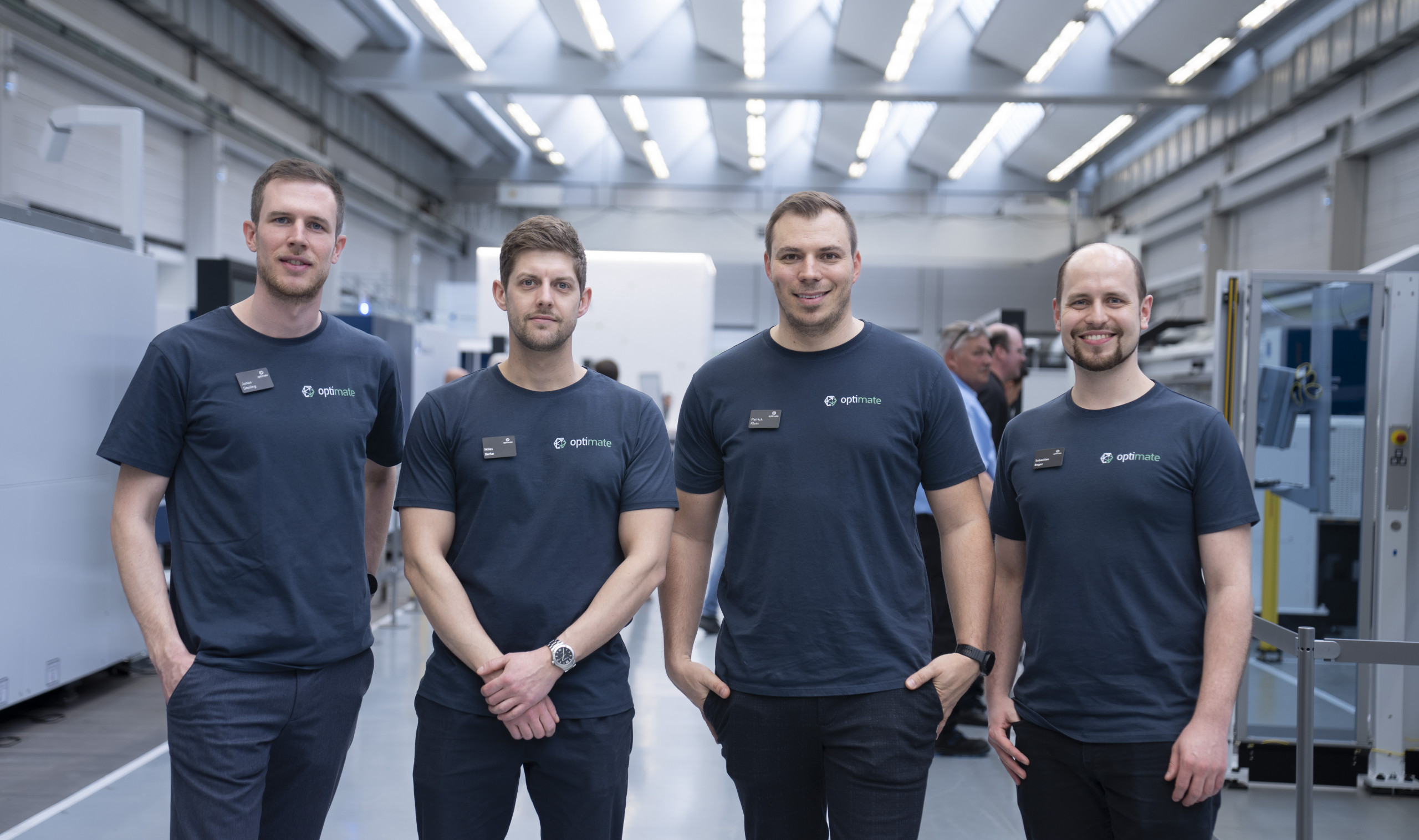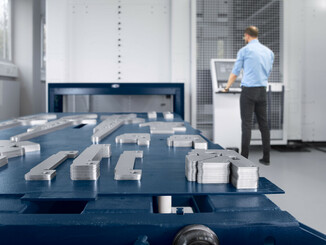
Cimbria in Austria wanted to replace a 130-year-old punching machine – a piece of industrial history. Many machine suppliers listened to the requirements, but only Trumpf dared to take on the task. In the end, the TruPunch 5000 not only replaced the historic machine, but also combined the tasks of seven machines.
The sheet weighs 40 kilos, which the production workers balance and clamp onto the old punching machine. Row by row, the machine pushes the sheet forward. The punching head lowers evenly and presses the shape into the thin material, always the same: twelve indentations, further, twelve indentations, further, two meters in one direction, two meters back, until the sheet is full. The sheet that is created here later sorts seeds. The technology is 130 years old, dating back to the early days of Cimbria Heid – and it will soon be retired.

© Trumpf
An investment in greater efficiency
Nikolaus Heid designed the punching machine in 1894. Since then, the company has repeatedly modernized the technology. “But we had to face reality and realize that at some point it would no longer work,” says Patrick Jansen, Director Manufacturing at Cimbria. He plans to decommission two of the old punching machines by the end of 2024. “Of course, there is a bit of melancholy,” he regrets, “the machines are part of Heid’s industrial history. But after 130 years, we also have to think about new technologies and the associated increase in efficiency.” Heid Agrartechnik has been part of the Danish company Cimbria since 1989. The punching machines are one of the company’s key technologies. “They process the sheets for a trieur: a machine that later sorts the grain or seed. This has always been one of our core competencies,” explains Patrick Jansen. The trieur sorts desired grains from unwanted grains. The metal sheets are later formed into cylinders that rotate around a chute. The indentations in the sheet – also known as “pockets” – hold the desired grain and transport it upwards. There it falls down onto the channel. Grains that do not fit into the recesses fall out of the cylinder again.

© Trumpf
The indentations have two challenges: their shape and their number on the surface. Depending on the desired grain size, a different depth is required. They range from the smallest indentations for clover seeds to 28 millimeter holes for sunflower seeds. The shape of the indentations is not always round; depending on the product to be sorted, it is more like a drop. And each shape requires its own tool. “You can press a bag relatively easily and quickly,” explains Austrian plant manager Günther Schwarz. “But pressing so many bags onto a two-metre-long sheet is a technical challenge.” In summer 2021, Patrick Jansen and Günther Schwarz began looking for alternatives to the old machines. It would take until September 2023 before they were able to put the new Trumpf punching machine into operation. “The old machines were so sacred, we couldn’t imagine that a modern machine could even process the sheet metal the way we needed it,” recalls Günther Schwarz. Cimbria contacted ten suppliers. All but Trumpf dropped out again. “In order to meet Cimbria’s requirements, we made several trips to Cimbria Heid,” recalls Peter Sternat, Trumpf Sales Manager for Eastern Austria, “and Günther Schwarz also visited our Customer Center in Ditzingen.” Together, they integrated the TruPunch 5000 into the layout of the current machine park and developed the first tool heads for the gob mold. “We approached it step by step,” adds Peter Sternat.

© Trumpf
Better capacity utilization thanks to state-of-the-art technology
For Cimbria Heid, the new machine means an increase in efficiency. Work steps that were previously carried out on different machines are now performed by the TruPunch 5000, which punches the indentations into the sheet at 1600 strokes per minute. Active hold-down devices prevent the material from swelling during this process, eliminating the need for subsequent straightening. One function cuts the sheet to the desired size, another deburrs the cut edges. Embossing tools mark the sheets. The SheetMaster now moves the 40 kilogram sheets – no longer the production employees. The tool change for more than 50 tools is also automated. Cimbria Heid produces the complex segmented sheets for the Trieur during the day in order to check the results. At night, the machine produces simpler flat screens without the need for personnel. “We can now utilize the machine much better – and our team is delighted with the new technology,” praises Patrick Jansen. Cimbria Heid has collected around 450 punching heads for various grain and seed shapes over 130 years. They also need these heads for the new machine. “We test every single tool so that the sorting plates continue to meet our quality standards. That will take some time,” explains Patrick Jansen. What will become of the old machines afterwards is still unclear. But the production manager is certain: “We will find a worthy place for them. Perhaps they will move into an industrial museum.”
Title: Laser cutting machine generates bevels during cutting

© Trumpf
At the EuroBlech trade fair in Hanover, Trumpf is launching a new machine that automatically prepares components for welding.
At the Euroblech trade fair in Hanover, Trumpf is launching a new machine that automatically prepares components for welding. The TruLaser Series 3000 Bevel Cut Edition can produce beveled cutting edges (chamfers) on the top and bottom edges of the component during the cutting process. This ensures optimum preparation of the welding edges and saves the otherwise necessary downstream work step. “With the TruLaser Series 3000 Bevel Cut Edition, users get a particularly productive universal machine with which they can integrate downstream process steps into laser processing,” promises Trumpf Product Manager Patrick Schüle. The new TruLaser Series 3000 Bevel Cut Edition can apply bevels to sheets of up to 25 millimeters. “Thanks to the unique design of the cutting unit, the machine can create bevels of up to 50 degrees depending on the sheet thickness, which is more than the 45 degrees that were previously standard in the industry,” explains Schüle. The machine can also handle complex bevel geometries with ease. The solution is particularly suitable for mild steel and stainless steel.
For 2D processing of components without bevels, users still have access to all the proven Trumpf functions for laser cutting, such as Highspeed Eco to reduce gas consumption, FlexLine for reliable processing of different material grades and EdgeLine Bevel for rounding the top edges of sheet metal.

© Trumpf
High flexibility in façade design
For this solution, Trumpf has equipped the cutting unit of the TruLaser Series 3000 Bevel Cut Edition with two additional rotary axes, particularly compact drive motors and a nozzle specially developed for bevel cutting. Thanks to the special design, the cutting head can be tilted in all directions up to an angle of 50 degrees. The cutting unit regulates the distance to the sheet as usual, minimizing the risk of collision despite the steep angle. The TruLaser Series 3000 Bevel Cut Edition is also equipped with Trumpf collision protection.
Thanks to the high flexibility of the cutting unit, it is possible to produce chamfers in different shapes. In addition to classic V and Y edges, bevel shapes are also possible in which both sides of the component edge are provided with bevel cuts, so-called DV and DY edges. This flexibility in edge shape is particularly advantageous when complex components or groups of components are to be welded. Trumpf meets the high demands placed on the preparation of complex bevel cuts with a new, particularly simple, intuitive programming. It contains a preselection of all processing strategies, which the user can flexibly adapt as required. Suitable predefined cutting parameters are also stored for the special bevel cut nozzles. The high productivity of the TruLaser Series 3000 is retained. Trumpf is launching the solution on the market at EuroBlech.
Web: www.trumpf.com



